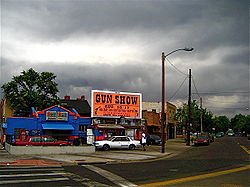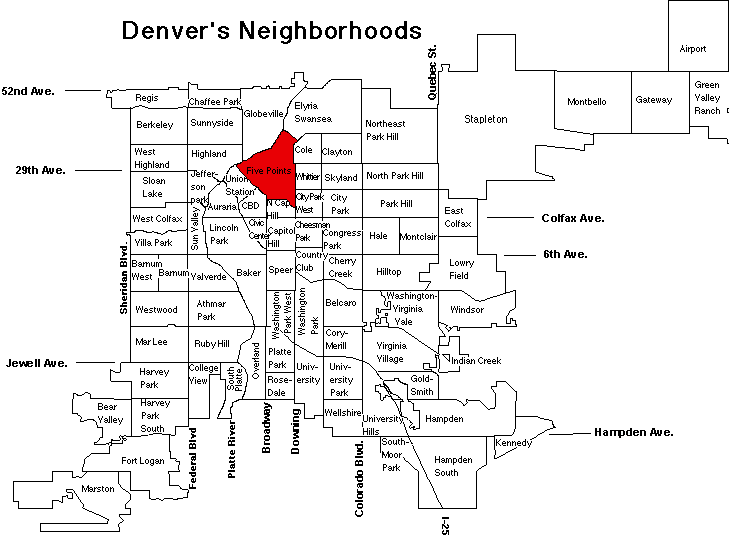.gif)
Five Points (Denver)
Encyclopedia

Colorado
Colorado is a U.S. state that encompasses much of the Rocky Mountains as well as the northeastern portion of the Colorado Plateau and the western edge of the Great Plains...
's oldest historic neighborhoods adjacent to the downtown
Downtown Denver
Downtown Denver is the main financial, commercial, and entertainment district in Denver, Colorado. There is over of office space in downtown Denver, with 130,000 workers....
central business district. The neighborhood is located in the area of Northeast Denver where the original downtown street grid meets the neighborhood street grid of the first Denver suburbs. Horse-drawn transit served this Denver neighborhood and the limited space to name the transit stops caused the area to be named Five Points. The Five Points transit stop culminated the names of the following streets: Washington Street, 27th Street, 26th Avenue and Welton Street.
Five Points came to significant historical prominence from the 1860s through the 1950s. The neighborhood was home to Denver's aristocracy, housing mayors, governors, and prominent business people. The Welton Street Business District, Clement neighborhood, San Rafael community, Curtis Park and Ballpark neighborhoods are located within the larger Five Points neighborhood.
History
Five Points is considered the "HarlemHarlem
Harlem is a neighborhood in the New York City borough of Manhattan, which since the 1920s has been a major African-American residential, cultural and business center. Originally a Dutch village, formally organized in 1658, it is named after the city of Haarlem in the Netherlands...
of the West" due to its long jazz history. It was the first predominantly African-American neighborhood in Denver. In the 1920s through 1950s the community thrived with a rich mix of local business and commerce along the Welton Corridor offering the neighborhood butcher, real estate companies, drug stores, religious organizations, tailors, restaurants, barbers and many other main street uses. Welton Street was also home to over fifty bars and clubs, where some of the greatest jazz musicians ever, such as Billie Holiday
Billie Holiday
Billie Holiday was an American jazz singer and songwriter. Nicknamed "Lady Day" by her friend and musical partner Lester Young, Holiday had a seminal influence on jazz and pop singing...
, Duke Ellington
Duke Ellington
Edward Kennedy "Duke" Ellington was an American composer, pianist, and big band leader. Ellington wrote over 1,000 compositions...
, Miles Davis
Miles Davis
Miles Dewey Davis III was an American jazz musician, trumpeter, bandleader, and composer. Widely considered one of the most influential musicians of the 20th century, Miles Davis was, with his musical groups, at the forefront of several major developments in jazz music, including bebop, cool jazz,...
, Nat King Cole
Nat King Cole
Nathaniel Adams Coles , known professionally as Nat King Cole, was an American musician who first came to prominence as a leading jazz pianist. Although an accomplished pianist, he owes most of his popular musical fame to his soft baritone voice, which he used to perform in big band and jazz genres...
, Count Basie
Count Basie
William "Count" Basie was an American jazz pianist, organist, bandleader, and composer. Basie led his jazz orchestra almost continuously for nearly 50 years...
, Dizzy Gillespie
Dizzy Gillespie
John Birks "Dizzy" Gillespie was an American jazz trumpet player, bandleader, singer, and composer dubbed "the sound of surprise".Together with Charlie Parker, he was a major figure in the development of bebop and modern jazz...
and many other legends performed. The Legendary Rossonian building, built in 1912, became the center of the Five Points community offering a premier hotel and jazz club still nationally known.


Throughout this period the historical prominence of Five Points continued to be celebrated through institutions such as the Black American West Museum and Heritage Center as well as the Blair-Caldwell African American Research Library
Blair-Caldwell African American Research Library
The Blair-Caldwell African American Research Library is a branch of the Denver Public Library that serves Denver's Five Points neighborhood and is also a research library with collections focusing on the history of African Americans in Denver and the American West...
. A number of African-American churches and businesses are still landmarks in the community.
Denver's Juneteenth
Juneteenth
Juneteenth, also known as Freedom Day or Emancipation Day, is a holiday in the United States honoring African American heritage by commemorating the announcement of the abolition of slavery in the U.S. State of Texas in 1865...
festival draws over 100,000 people every year. It starts at Manual High School
Manual High School (Denver)
Manual High School is located in the Whittier neighborhood on the east side of Denver, Colorado.-Demographics:*5.6% white*40.9% African American*58.1% Latino*0% Native American*0.3% Asian- Manual Today :...
and goes down to Welton Street in Five Points, where thousands of vendors sell merchandise and street performers perform.

As of 2009, the racial makeup of the neighborhood was 8.08% white
White
White is a color, the perception of which is evoked by light that stimulates all three types of color sensitive cone cells in the human eye in nearly equal amounts and with high brightness compared to the surroundings. A white visual stimulation will be void of hue and grayness.White light can be...
, 33.12% African American
African American
African Americans are citizens or residents of the United States who have at least partial ancestry from any of the native populations of Sub-Saharan Africa and are the direct descendants of enslaved Africans within the boundaries of the present United States...
, 0.6% Asian
Asian people
Asian people or Asiatic people is a term with multiple meanings that refers to people who descend from a portion of Asia's population.- Central Asia :...
, and 1.32% Native American
Indigenous peoples of the Americas
The indigenous peoples of the Americas are the pre-Columbian inhabitants of North and South America, their descendants and other ethnic groups who are identified with those peoples. Indigenous peoples are known in Canada as Aboriginal peoples, and in the United States as Native Americans...
. Hispanic
Hispanic
Hispanic is a term that originally denoted a relationship to Hispania, which is to say the Iberian Peninsula: Andorra, Gibraltar, Portugal and Spain. During the Modern Era, Hispanic sometimes takes on a more limited meaning, particularly in the United States, where the term means a person of ...
or Latino
Latino
The demonyms Latino and Latina , are defined in English language dictionaries as:* "a person of Latin-American descent."* "A Latin American."* "A person of Hispanic, especially Latin-American, descent, often one living in the United States."...
of any race is 56.84% of the population.

